Multivariate Analysis for Assessing Sources, and Potential Risks of Polycyclic Aromatic Hydrocarbons in Lisbon Urban Soils
Abstract
1. Introduction
2. Materials and Methods
3. Results and Discussion
3.1. General Characterization and Levels of PAHs in Lisbon Urban Soils
3.2. Source Apportionment of PAHs in Lisbon Urban Soils
3.3. Risk Assessment of PAHs in Lisbon Soils
3.4. Potential Risks to the Environmental Health (ERA)
3.5. Potential Risks to Human Health (HHRA)
4. Conclusions
Supplementary Materials
Author Contributions
Funding
Acknowledgments
Conflicts of Interest
References
- Cachada, A.; Coelho, C.; Gavina, A.; Dias, A.C.; Patinha, C.; Reis, A.P.; da Silva, E.F.; Duarte, A.C.; Pereira, R. Availability of polycyclic aromatic hydrocarbons to earthworms in urban soils and its implications for risk assessment. Chemosphere 2018, 191, 196–203. [Google Scholar] [CrossRef] [PubMed]
- Cachada, A.; Ferreira da Silva, E.; Duarte, A.C.; Pereira, R. Risk assessment of urban soils contamination: The particular case of polycyclic aromatic hydrocarbons. Sci. Total Environ. 2016, 551–552, 271–284. [Google Scholar] [CrossRef] [PubMed]
- Cachada, A.; Pato, P.; Rocha-Santos, T.; da Silva, E.F.; Duarte, A.C. Levels, sources and potential human health risks of organic pollutants in urban soils. Sci. Total Environ. 2012, 430, 184–192. [Google Scholar] [CrossRef] [PubMed]
- Orecchio, S. Contamination from polycyclic aromatic hydrocarbons (PAHs) in the soil of a botanic garden localized next to a former manufacturing gas plant in Palermo (Italy). Hazard. Mater. 2010, 180, 590–601. [Google Scholar] [CrossRef] [PubMed]
- Jensen, J.; Mesman, M. Ecological Risk Assessment of Contaminated Land. Decision Support for Site Specific Investigations; Report No. 711701047; National Institute of Public Health and the Environment: Bilthoven, The Netherlands, 2006. [Google Scholar]
- Swartjes, F.A.; Rutgers, M.; Lijzen, J.P.A.; Janssen, P.J.C.M.; Otte, P.F.; Wintersen, A.; Brand, E.; Posthuma, L. State of the art of contaminated site management in The Netherlands: Policy framework and risk assessment tools. Sci. Total Environ. 2012, 427–428, 1–10. [Google Scholar] [CrossRef] [PubMed]
- Goovaerts, P. Geostatistics for Natural Resouces Evaluation; Oxford University Press: New York, NY, USA, 1997. [Google Scholar]
- Albanese, S.; Fontaine, B.; Chen, W.; Lima, A.; Cannatelli, C.; Piccolo, A.; Qi, S.; Wang, M.; De Vivo, B. Polycyclic aromatic hydrocarbons in the soils of a densely populated region and associated human health risks: The Campania Plain (Southern Italy) case study. Environ. Geochem. Health 2015, 37, 1–20. [Google Scholar] [CrossRef] [PubMed]
- Peng, C.; Chen, W.; Liao, X.; Wang, M.; Ouyang, Z.; Jiao, W.; Bai, Y. Polycyclic aromatic hydrocarbons in urban soils of Beijing: Status, sources, distribution and potential risk. Environ. Pollut. 2011, 159, 802–808. [Google Scholar] [CrossRef] [PubMed]
- Peng, C.; Ouyang, Z.; Wang, M.; Chen, W.; Li, X.; Crittenden, J.C. Assessing the combined risks of PAHs and metals in urban soils by urbanization indicators. Environ. Pollut. 2013, 178, 426–432. [Google Scholar] [CrossRef] [PubMed]
- Wang, C.; Wu, S.; Zhou, S.; Wang, H.; Li, B.; Chen, H.; Yu, Y.; Shi, Y. Polycyclic aromatic hydrocarbons in soils from urban to rural areas in Nanjing: Concentration, source, spatial distribution, and potential human health risk. Sci. Total Environ. 2015, 527–528, 375–383. [Google Scholar] [CrossRef] [PubMed]
- Wang, X.-T.; Chen, L.; Wang, X.-K.; Lei, B.-L.; Sun, Y.-F.; Zhou, J.; Wu, M.-H. Occurrence, sources and health risk assessment of polycyclic aromatic hydrocarbons in urban (Pudong) and suburban soils from Shanghai in China. Chemosphere 2015, 119, 1224–1232. [Google Scholar] [CrossRef] [PubMed]
- Cachada, A.; Dias, A.C.; Pato, P.; Mieiro, C.; Rocha-Santos, T.; Pereira, M.E.; Ferreira da Silva, E.; Duarte, A.C. Major inputs and mobility of potentially toxic elements contamination in urban areas. Environ. Monit. Assess. 2013, 185, 279–294. [Google Scholar] [CrossRef] [PubMed]
- Costa, C.; Reis, A.P.; Ferreira da Silva, E.; Rocha, F.; Patinha, C.; Dias, A.C.; Sequeira, C.; Terroso, D. Assessing the control exerted by soil mineralogy in the fixation of potentially harmful elements in the urban soils of Lisbon, Portugal. Environ. Earth Sci. 2012, 65, 1133–1145. [Google Scholar] [CrossRef]
- Reis, A.P.; Patinha, C.; Wragg, J.; Dias, A.C.; Cave, M.; Sousa, A.J.; Costa, C.; Cachada, A.; Ferreira da Silva, E.; Rocha, F.; et al. Geochemistry, mineralogy, solid-phase fractionation and oral bioaccessibility of lead in urban soils of Lisbon. Environ. Geochem. Health 2014, 36, 867–881. [Google Scholar] [CrossRef] [PubMed]
- Cachada, A.; Pereira, M.E.; Ferreira da Silva, E.; Duarte, A.C. Sources of potentially toxic elements and organic pollutants in an urban area subjected to an industrial impact. Environ. Monit. Assess. 2012, 184, 15–32. [Google Scholar] [CrossRef] [PubMed]
- CCME. Polycyclic aromatic hydrocarbons. In Canadian Soil Quality Guidelines for Protection of Environmental and Human Health; Canadian Council of Ministers of the Environment: Winnipeg, MB, Canada, 2010. [Google Scholar]
- USEPA. Exposure Factors Handbook: 2011 Edition; EPA/600/R-09/052F; U.S. Environmental Protection Agency: Washington, DC, USA, 2011.
- USEPA. Risk Assessment Guidance for Superfund. Volume I—Human Health Evaluation Manual (Part B, Development of Risk-Based Preliminary Remediation Goals); Office of Research and Development, U.S. Environmental Protection Agency: Washington, DC, USA, 1991.
- Ferreira, A.; Inácio, M.; Morgado, P.; Batista, M.; Ferreira, L.; Pereira, V.; Pinto, M. Low-density geochemical mapping in Portugal. Appl. Geochem. 2001, 16, 1323–1331. [Google Scholar] [CrossRef]
- Liu, S.; Xia, X.; Yang, L.; Shen, M.; Liu, R. Polycyclic aromatic hydrocarbons in urban soils of different land uses in Beijing, China: Distribution, sources and their correlation with the city’s urbanization history. J. Hazard. Mater. 2010, 177, 1085–1092. [Google Scholar] [CrossRef] [PubMed]
- Wilcke, W.; Müller, S.; Kanchanakool, N.; Niamskul, C.; Zech, W. Polycyclic aromatic hydrocarbons in hydromorphic soils of the tropical metropolis Bangkok. Geoderma 1999, 91, 297–309. [Google Scholar] [CrossRef]
- Morillo, E.; Romero, A.S.; Maqueda, C.; Madrid, L.; Ajmone-Marsan, F.; Grcman, H.; Davidson, C.M.; Hursthouse, A.S.; Villaverde, J. Soil pollution by PAHs in urban soils: A comparison of three European cities. J. Environ. Monit. 2007, 9, 1001. [Google Scholar] [CrossRef] [PubMed]
- Nadal, M.; Schuhmacher, M.; Domingo, J.L. Levels of metals, PCBs, PCNs and PAHs in soils of a highly industrialized chemical/petrochemical area: Temporal trend. Chemosphere 2007, 66, 267–276. [Google Scholar] [CrossRef] [PubMed]
- Liu, Y.; Chen, L.; Zhao, J.; Wei, Y.; Pan, Z.; Meng, X.-Z.; Huang, Q.; Li, W. Polycyclic aromatic hydrocarbons in the surface soil of Shanghai, China: Concentrations, distribution and sources. Org. Geochem. 2010, 41, 355–362. [Google Scholar] [CrossRef]
- Chung, M.K.; Hu, R.; Cheung, K.C.; Wong, M.H. Pollutants in Hong Kong soils: Polycyclic aromatic hydrocarbons. Chemosphere 2007, 67, 464–473. [Google Scholar] [CrossRef] [PubMed]
- Ma, W.-L.; Li, Y.-F.; Sun, D.-Z.; Qi, H. Polycyclic Aromatic Hydrocarbons and Polychlorinated Biphenyls in Topsoils of Harbin, China. Arch. Environ. Contam. Toxicol. 2009, 57, 670–678. [Google Scholar] [CrossRef] [PubMed]
- Boonyatumanond, R.; Murakami, M.; Wattayakorn, G.; Togo, A.; Takada, H. Sources of polycyclic aromatic hydrocarbons (PAHs) in street dust in a tropical Asian mega-city, Bangkok, Thailand. Sci. Total Environ. 2007, 384, 420–432. [Google Scholar] [CrossRef] [PubMed]
- Ravindra, K.; Sokhi, R.; Vangrieken, R. Atmospheric polycyclic aromatic hydrocarbons: Source attribution, emission factors and regulation. Atmos. Environ. 2008, 42, 2895–2921. [Google Scholar] [CrossRef]
- Bozlaker, A.; Muezzinoglu, A.; Odabasi, M. Atmospheric concentrations, dry deposition and air–soil exchange of polycyclic aromatic hydrocarbons (PAHs) in an industrial region in Turkey. J. Hazard. Mater. 2008, 153, 1093–1102. [Google Scholar] [CrossRef] [PubMed]
- Brändli, R.C.; Bucheli, T.D.; Ammann, S.; Desaules, A.; Keller, A.; Blum, F.; Stahel, W.A. Critical evaluation of PAH source apportionment tools using data from the Swiss soil monitoring network. J. Environ. Monit. 2008, 10, 1278. [Google Scholar] [CrossRef] [PubMed]
- Wilcke, W. Global patterns of polycyclic aromatic hydrocarbons (PAHs) in soil. Geoderma 2007, 141, 157–166. [Google Scholar] [CrossRef]
- Zhang, X.L.; Tao, S.; Liu, W.X.; Yang, Y.; Zuo, Q.; Liu, S.Z. Source Diagnostics of Polycyclic Aromatic Hydrocarbons Based on Species Ratios: A Multimedia Approach. Environ. Sci. Technol. 2005, 39, 9109–9114. [Google Scholar] [CrossRef] [PubMed]
- Yunker, M.B.; Macdonald, R.W.; Vingarzan, R.; Mitchell, R.H.; Goyette, D.; Sylvestre, S. PAHs in the Fraser River basin: A critical appraisal of PAH ratios as indicators of PAH source and composition. Org. Geochem. 2002, 33, 489–515. [Google Scholar] [CrossRef]
- VROM. Circular on Target Values and Intervention Values for Soil Remediation: BO/1999226863. General for environment protection, Department of Soil Protection. Netherlands Government Gazette, 24 February 2000. [Google Scholar]
- Carlon, C. Derivation Methods of Soil Screening Values in Europe. A Review and Evaluation of National Procedures Towards Harmonisation; European Commission, Joint Research Center: Ispra, Italy, 2007. [Google Scholar]
- DEPA. Guidelines on Remediation of Contaminated Sites. Environmental Guidelines No 7; Danish Ministry of Environment: Copenhagen, Denmark, 2002. [Google Scholar]
- MP. REAL DECRETO 9/2005; Ministerio de la Presidencia: Madrid, Spain, 2005. [Google Scholar]
- EU. Coal-Tar Pitch, High Temperature, R323_0805_ENV_FINAL_ECB; European Union Risk Assessment Report; European Union: Maastricht, The Netherlands, 2008. [Google Scholar]
- Verbruggen, E.M.J. Environmental Risk Limits for Polycyclic Aromatic Hydrocarbons (PAHs)—For Direct Aquatic, Benthic, and Terrestrial Toxicity; National Institute for Public Health and the Environment: Bilthoven, The Netherlands, 2012; p. 339. [Google Scholar]
- Swartjes, F.A.; Carlon, C.; de Wit, N.H.S.M. The possibilities for the EU-wide use of similar ecological risk-based soil contamination assessment tools. Sci. Total Environ. 2008, 406, 523–529. [Google Scholar] [CrossRef] [PubMed]
- Jiang, Y.-F.; Wang, X.-T.; Wang, F.; Jia, Y.; Wu, M.-H.; Sheng, G.-Y.; Fu, J.-M. Levels, composition profiles and sources of polycyclic aromatic hydrocarbons in urban soil of Shanghai, China. Chemosphere 2009, 75, 1112–1118. [Google Scholar] [CrossRef] [PubMed]
- Nadal, M.; Schuhmacher, M.; Domingo, J.L. Probabilistic human health risk of PCDD/F exposure: A socioeconomic assessment. J. Environ. Monit. 2004, 6, 926. [Google Scholar] [CrossRef] [PubMed]
- USEPA. Regional Screening Levels for Chemical Contaminants at Superfund Sites. Regional Screening Table User’s Guide; U.S. Environmental Protection Agency: Washington, DC, USA, 2011. Available online: http://www.epa.gov/reg3hwmd/risk/human/rb-concentration_table/usersguide.htm (accessed on 26 February 2019).
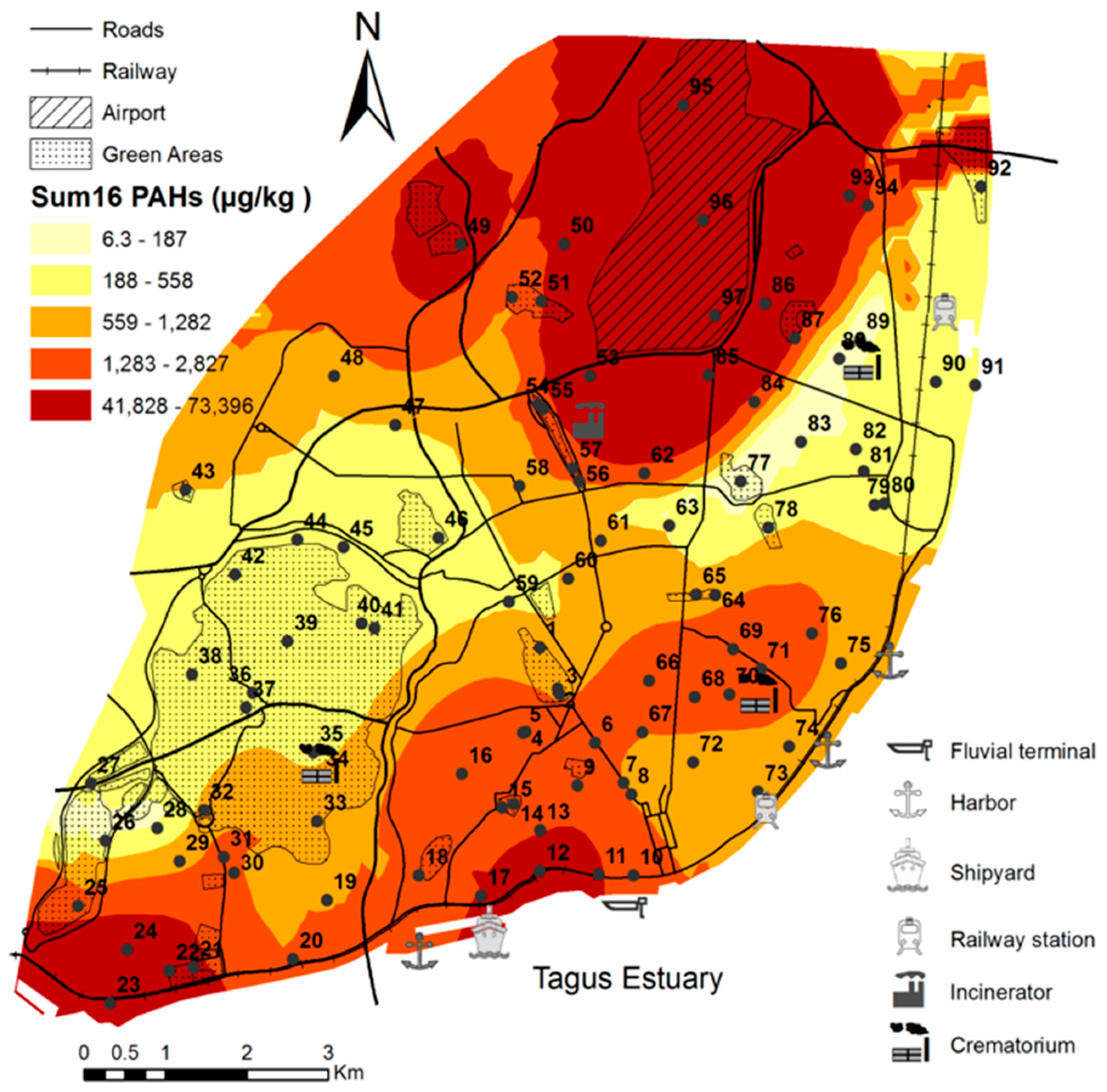
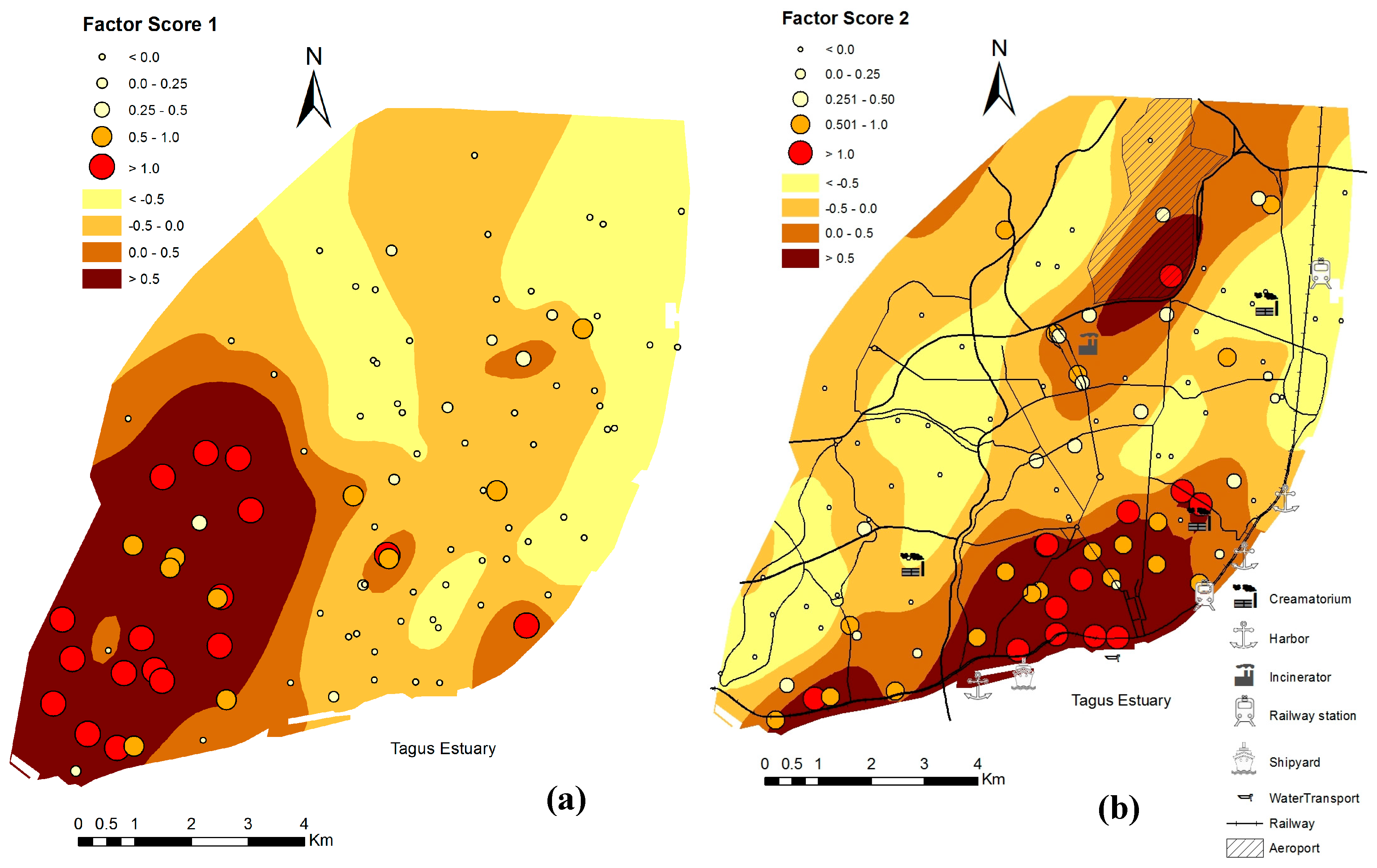
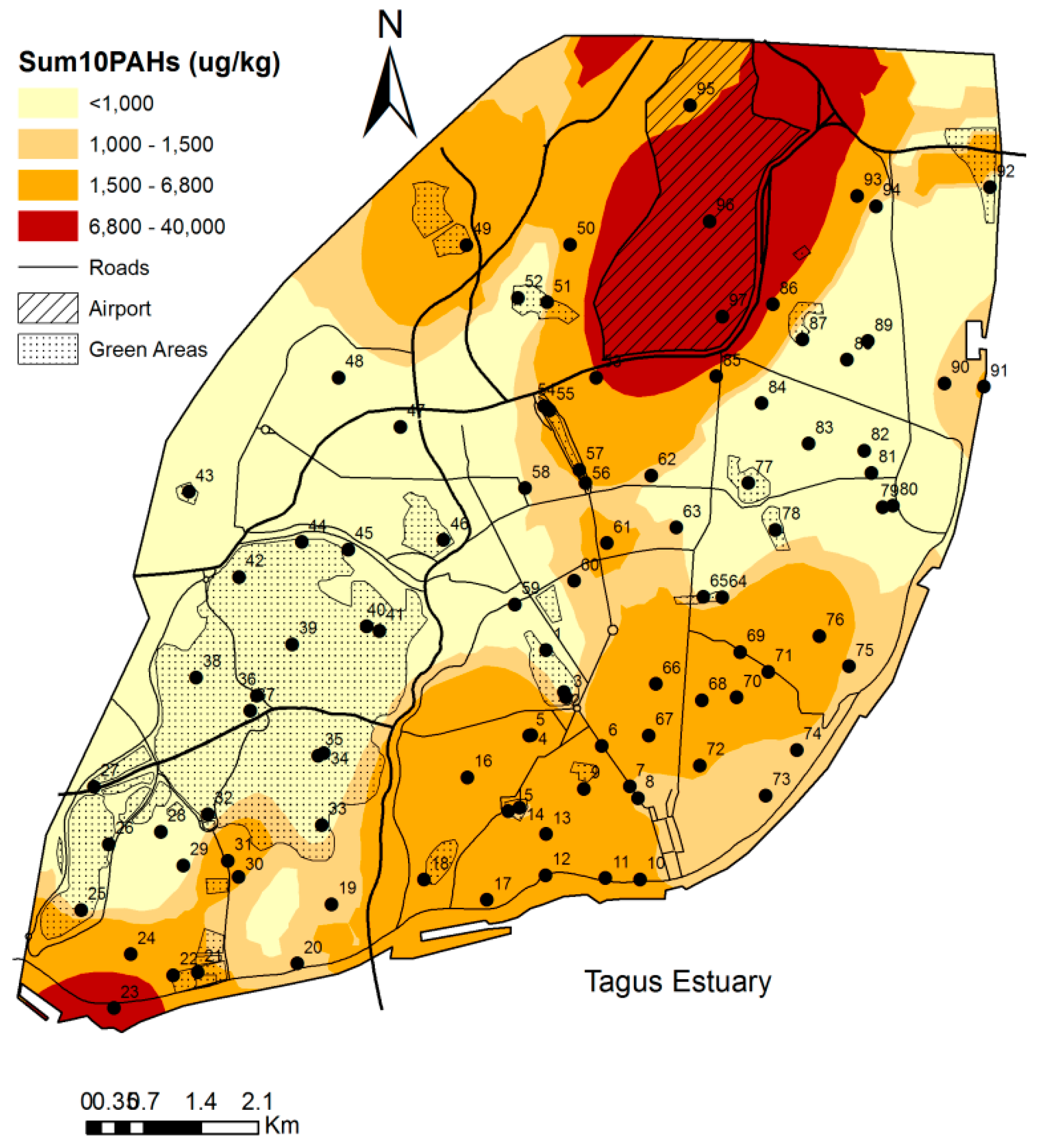

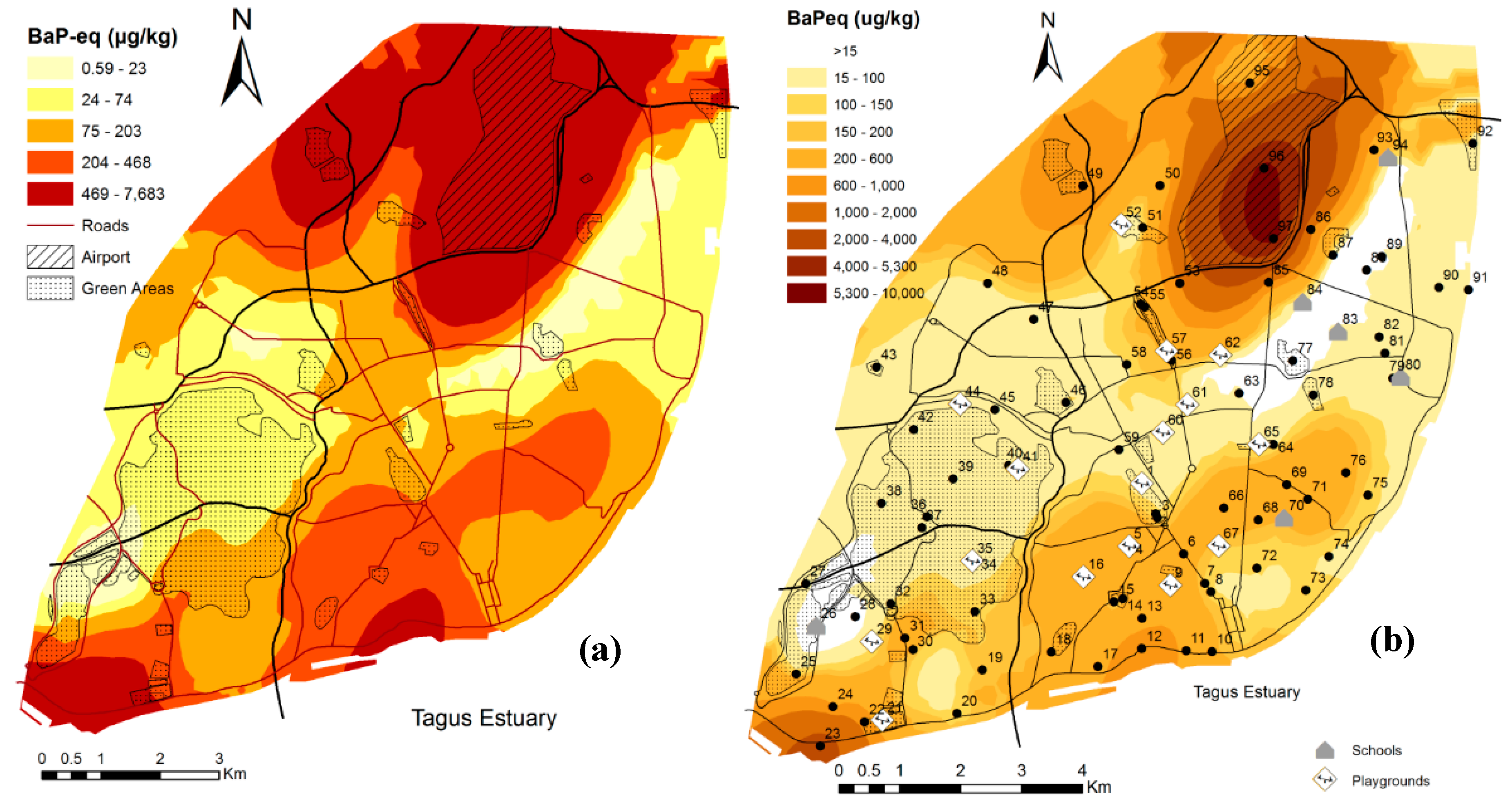
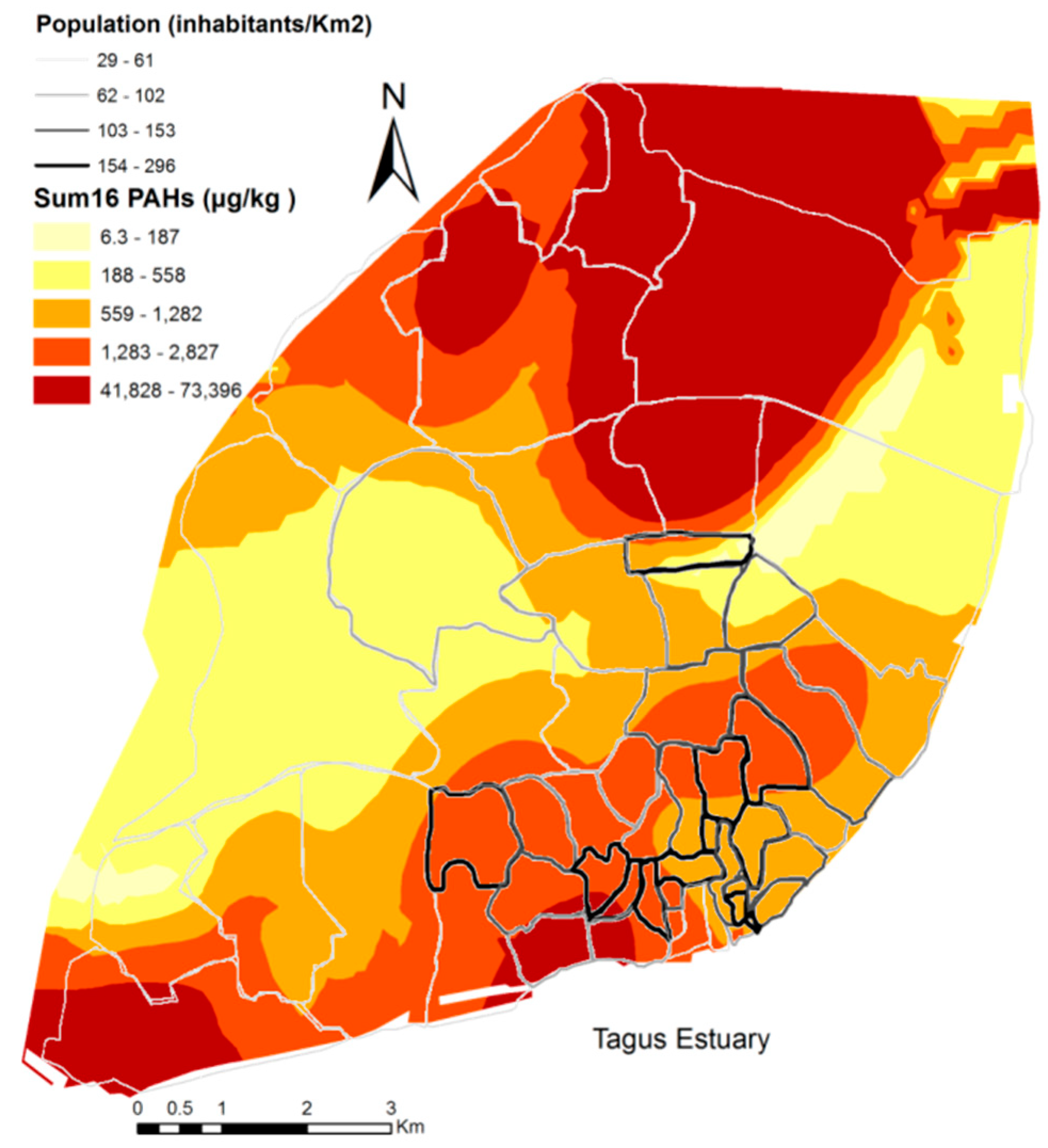
| City | Inhab. | Median | Mean | Min | Max | Reference |
|---|---|---|---|---|---|---|
| Lisbon, Portugal | 564,567 | 559 | 2645 | 6.3 | 73,395 | This study |
| 456 | 1544 | 6.3 | 22,670 | [3] | ||
| Viseu, Portugal | 47,250 | 83 | 169 | 6.0 | 790 | [3] |
| Estarreja, Portugal | 7000 | 98 | - | 27 | 2016 | [16] |
| Palermo, Italy | 850,000 | - | - | 947 b | 18,072 b | [4] |
| Glasgow, Scotland | 600,000 | 8337 a | 11,930 a | 1487 a | 51,822 a | [23] |
| Torino, Italy | 900,000 | 704 a | 1990 a | 148 a | 23,500 a | [23] |
| Ljubljana, Slovenia | 300,000 | 791 a | 989 a | 218 a | 4488 a | [23] |
| Terragona, Spain | 155,000 | - | 438 | 42 | 1472 | [24] |
| Beijing, China | 18,000,000 | 688 | 1228 | 93 | 13,141 | [9] |
| Shangai, China | 20,600,000 | 314 | 1700 | 62 | 31,900 | [25] |
| Hong Kong | 6,800,000 | 140 | - | ND | 19,500 | [26] |
| Harbin, China | 3,800,000 | 301 | 837 | 202 | 3256 | [27] |
| Factor 1 | Factor 2 | Communalities | Factor 1 | Factor 2 | Communalities | |
|---|---|---|---|---|---|---|
| Al | 0.964 | 0.118 | 0.944 | 0.972 | 0.103 | 0.956 |
| Fe | 0.966 | 0.202 | 0.974 | 0.965 | 0.186 | 0.967 |
| Co | 0.950 | 0.121 | 0.917 | 0.944 | 0.110 | 0.903 |
| Cr | 0.933 | 0.229 | 0.924 | 0.918 | 0.214 | 0.889 |
| Ni | 0.949 | 0.194 | 0.938 | 0.936 | 0.183 | 0.910 |
| Ca | 0.309 | 0.650 | 0.518 | 0.347 | 0.643 | 0.533 |
| Cu | 0.441 | 0.785 | 0.810 | 0.430 | 0.777 | 0.788 |
| Hg | 0.026 | 0.862 | 0.744 | 0.018 | 0.856 | 0.733 |
| Pb | 0.078 | 0.948 | 0.904 | 0.088 | 0.856 | 0.899 |
| Zn | 0.412 | 0.797 | 0.805 | 0.424 | 0.795 | 0.812 |
| Sum16 | 0.005 | 0.864 | 0.747 | 0.022 | 0.867 | 0.753 |
| Clay | - | - | - | 0.753 | 0.223 | 0.616 |
| OC | - | - | - | 0.500 | 0.418 | 0.424 |
| Eigenvalue | 6.5 | 2.8 | - | 7.3 | 57 | - |
| % CEV | 59 | 84 | - | 2.8 | 78 | - |
| Compound | PNEC | HC5 | ||||||
|---|---|---|---|---|---|---|---|---|
| Min | Med | Max | TU > 1 (%) | Min | Med | Max | TU > 1 (%) | |
| NP | 0.00 | 0.00 | 0.05 | 0 | 0.00 | 0.02 | 0.33 | 0 |
| ACY | 0.00 | 0.00 | 0.25 | 0 | 0.00 | 0.01 | 0.42 | 0 |
| ACE | 0.00 | 0.00 | 1.0 | 0 | 0.00 | 0.00 | 0.20 | 0 |
| FLU | 0.00 | 0.00 | 0.03 | 0 | 0.00 | 0.01 | 0.17 | 0 |
| PHE | 0.00 | 0.01 | 0.49 | 0 | 0.00 | 0.09 | 3.4 | 5 |
| ANT | 0.00 | 0.03 | 1.3 | 1 | 0.00 | 0.02 | 0.70 | 0 |
| FLA | 0.00 | 0.03 | 2.9 | 2 | 0.00 | 0.13 | 13 | 8 |
| PYR | 0.00 | 0.04 | 3.3 | 3 | 0.01 | 0.13 | 11 | 8 |
| BAA | 0.00 | 0.28 | 23 | 17 | 0.00 | 0.03 | 2.8 | 2 |
| CRY | 0.00 | 0.05 | 3.2 | 3 | 0.00 | 0.05 | 3.0 | 3 |
| BBF | 0.00 | 0.11 | 7.5 | 5 | 0.00 | 0.03 | 2.4 | 3 |
| BKF | 0.00 | 0.07 | 5.0 | 4 | 0.00 | 0.02 | 1.6 | 1 |
| BAP | 0.00 | 0.51 | 25 | 33 | 0.00 | 0.03 | 1.0 | 0 |
| IND | 0.00 | 0.22 | 9.4 | 13 | 0.00 | 0.02 | 0.70 | 0 |
| DBAH | 0.00 | 0.10 | 4.8 | 5 | 0.00 | 0.00 | 0.20 | 0 |
| BGHI | 0.00 | 0.19 | 6.1 | 11 | 0.00 | 0.03 | 1.0 | 0 |
| TUm | 0.03 | 1.8 | 93 | 60 | 0.03 | 0.62 | 42 | 38 |
| Compound | Dutch MPC | Dutch SRC | Spanish | Canadian | ||||||||
|---|---|---|---|---|---|---|---|---|---|---|---|---|
| Min | Med | Max | Min | Med | Max | Min | Med | Max | Min | Med | Max | |
| NP | 0.00 | 0.01 | 0.15 | 0.00 | 0.00 | 0.01 | 0.00 | 0.02 | 0.31 | 0.00 | 0.00 | 0.15 |
| ACY | 0.00 | 0.01 | 0.56 | 0.00 | 0.00 | 0.02 | - | - | - | - | - | - |
| ACE | 0.00 | 0.00 | 0.12 | 0.00 | 0.00 | 0.00 | - | - | - | - | - | - |
| FLU | 0.00 | 0.00 | 0.05 | 0.00 | 0.00 | 0.00 | 0.00 | 0.00 | 0.12 | - | - | - |
| PHE | 0.00 | 0.01 | 0.41 | 0.00 | 0.00 | 0.02 | - | - | - | 0.00 | 0.00 | 0.49 |
| ANT | 0.00 | 0.03 | 0.61 | 0.00 | 0.00 | 0.01 | - | - | - | 0.00 | 0.00 | 0.21 |
| FLA | 0.00 | 0.02 | 0.75 | 0.00 | 0.00 | 0.03 | 0.00 | 0.03 | 0.83 | 0.00 | 0.00 | 0.25 |
| PYR | 0.00 | 0.05 | 0.86 | 0.00 | 0.00 | 0.14 | - | - | - | 0.00 | 0.00 | 0.58 |
| BAA | 0.00 | 0.24 | 0.97 | 0.00 | 0.00 | 0.04 | 0.00 | 0.00 | 0.31 | 0.00 | 0.03 | 0.86 |
| CRY | 0.00 | 0.04 | 0.78 | 0.00 | 0.00 | 0.10 | - | - | - | - | - | - |
| BBF | 0.00 | 0.09 | 0.90 | 0.00 | 0.00 | 0.08 | - | - | - | 0.00 | 0.05 | 0.90 |
| BKF | 0.00 | 0.05 | 0.85 | 0.00 | 0.00 | 0.07 | - | - | - | 0.00 | 0.02 | 0.81 |
| BAP | 0.00 | 0.32 | 0.97 | 0.00 | 0.00 | 0.04 | 0.00 | 0.13 | 0.91 | 0.00 | 0.00 | 0.17 |
| IND | 0.00 | 0.16 | 0.92 | 0.00 | 0.00 | 0.03 | - | - | - | 0.00 | 0.03 | 0.80 |
| DBAH | 0.00 | 0.07 | 0.83 | 0.00 | 0.00 | 0.03 | - | - | - | 0.00 | 0.01 | 0.50 |
| BGHI | 0.00 | 0.14 | 0.88 | 0.00 | 0.01 | 0.22 | - | - | - | - | - | - |
| TPm | 0.03 | 0.77 | 1.00 | 0.00 | 0.01 | 0.58 | 0.00 | 0.19 | 0.99 | 0.00 | 0.15 | 1.00 |
| Statistical Data | Cancer Risk | Mutagenic Risk | |||
|---|---|---|---|---|---|
| Residential | Worker | Recreational | Residential | Recreational | |
| UCL | 8.97 × 10−6 | 2.38 × 10−6 | 5.06 × 10−7 | 3.33 × 10−5 | 2.13 × 10−6 |
| median | 1.19 × 10−6 | 3.16 × 10−7 | 7.54 × 10−8 | 4.66 × 10−6 | 3.17 × 10−7 |
| mean | 5.59 × 10−6 | 1.48 × 10−6 | 2.39 × 10−7 | 2.19 × 10−5 | 1.01 × 10−6 |
| 90% | 9.88 × 10−6 | 2.62 × 10−6 | 6.71 × 10−7 | 3.99 × 10−5 | 2.82 × 10−6 |
| min | 9.50 × 10−9 | 2.52 × 10−9 | 7.07 × 10−10 | 3.53 × 10−8 | 2.97 × 10−9 |
| max | 1.24 × 10−4 | 3.28 × 10−5 | 4.13 × 10−6 | 4.59 × 10−4 | 1.74 × 10−5 |
© 2019 by the authors. Licensee MDPI, Basel, Switzerland. This article is an open access article distributed under the terms and conditions of the Creative Commons Attribution (CC BY) license (http://creativecommons.org/licenses/by/4.0/).
Share and Cite
Cachada, A.; Dias, A.C.; Reis, A.P.; Ferreira da Silva, E.; Pereira, R.; Duarte, A.d.C.; Patinha, C. Multivariate Analysis for Assessing Sources, and Potential Risks of Polycyclic Aromatic Hydrocarbons in Lisbon Urban Soils. Minerals 2019, 9, 139. https://doi.org/10.3390/min9030139
Cachada A, Dias AC, Reis AP, Ferreira da Silva E, Pereira R, Duarte AdC, Patinha C. Multivariate Analysis for Assessing Sources, and Potential Risks of Polycyclic Aromatic Hydrocarbons in Lisbon Urban Soils. Minerals. 2019; 9(3):139. https://doi.org/10.3390/min9030139
Chicago/Turabian StyleCachada, Anabela, Ana Claudia Dias, Amélia Paula Reis, Eduardo Ferreira da Silva, Ruth Pereira, Armando da Costa Duarte, and Carla Patinha. 2019. "Multivariate Analysis for Assessing Sources, and Potential Risks of Polycyclic Aromatic Hydrocarbons in Lisbon Urban Soils" Minerals 9, no. 3: 139. https://doi.org/10.3390/min9030139
APA StyleCachada, A., Dias, A. C., Reis, A. P., Ferreira da Silva, E., Pereira, R., Duarte, A. d. C., & Patinha, C. (2019). Multivariate Analysis for Assessing Sources, and Potential Risks of Polycyclic Aromatic Hydrocarbons in Lisbon Urban Soils. Minerals, 9(3), 139. https://doi.org/10.3390/min9030139










